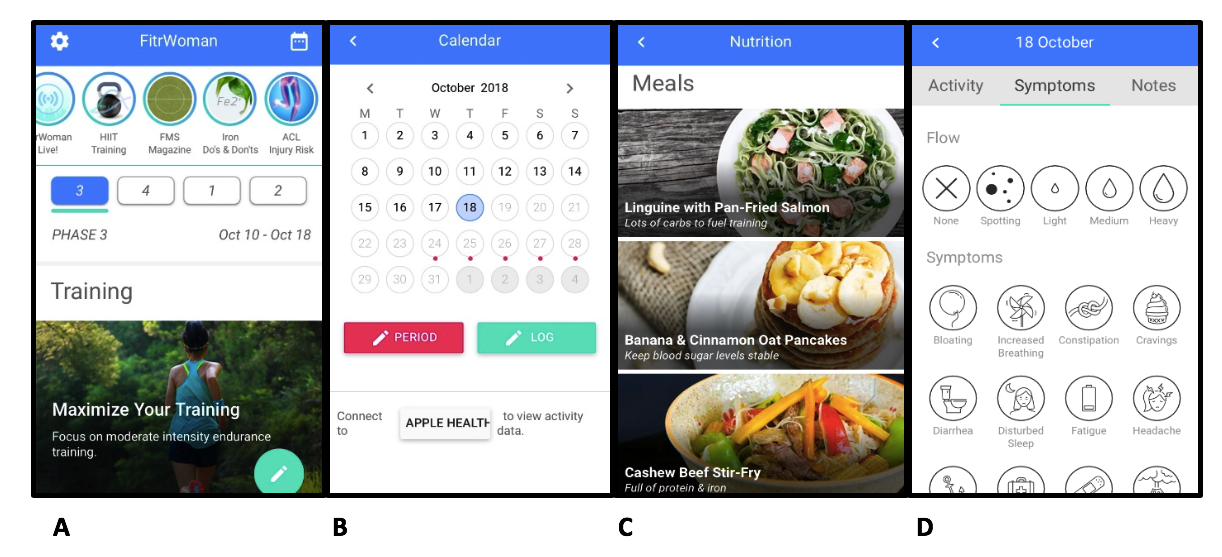By Nicola Brown @DrNikkiBrown
APP REVIEW
NAME OF THE MOBILE APPLICATION
FitrWoman – Know Your Cycle
CATEGORY OF THE MOBILE APPLICATION
Health and Fitness
PLATFORM
Android: Version 2.0 and above. iOS. Requires iOS 9.0 or later. Compatible with iPhone, iPad and iPod touch
COST
Free
ABOUT THE APP
Over three-quarters of exercising women report that their menstrual cycle has a negative impact on exercise training and performance [1], highlighting the need to understand female physiology and define the effects of cyclical variations in hormones on athletic performance [2]. Heavy menstrual bleeding is common in exercising women and is a leading cause of loss of iron, an essential micronutrient vital for metabolic and physiological function [3]. Furthermore, during the preovulatory phase of the menstrual cycle, ligament laxity is increased, therefore risk of certain injury types associated with this, such as anterior cruciate ligament damage may increase [4].
The FitrWoman app lets females track their menstrual cycle, report symptoms, log training activity and provides personalised training suggestions tailored to fluctuating hormone levels throughout their cycle. This enables females to adapt their training to gain maximum benefits, reduce injury risk and know when to prioritise recovery, while also letting them know when to expect their next period. For example, due to fluctuations in oestrogen and progesterone levels just after the ovulatory phase, users are encouraged to focus on moderate intensity endurance training and reduce resistance load, while eating a diet rich in protein to aid muscle recovery and refuel. Aimed at both recreational and elite athletes, the app also offers nutritional insights and recipes to reduce menstrual cycle symptoms and support training and recovery throughout the menstrual cycle. Explanations for how fluctuating hormone levels influence physiological function, appetite regulation, and emotions are also provided. Although there is a significant under-representation of women in sport and exercise medicine research studies [2], this is a rapidly evolving area and the app is regularly updated to incorporate the latest research that focuses on optimizing female health and performance.
USE IN CLINICAL PRACTICE
The app can assist athletes, coaches, support staff and practitioners to devise appropriate training and nutritional strategies in each phase of an athlete’s menstrual cycle, to optimize health and performance and minimize injury risk. It also enables users to know where they are at in their menstrual cycle.
PROS:
- Interactive, visual and easy-to-use interface, currently being regularly updated.
- Regular updates providing blogs, tips and research on optimising female health and performance.
- Ability to sync with Apple Health.
- Ability to sync with ‘FitrCoach’ (paid app) so that FitrWoman users can share their profiles with their coaches can support users during each phase of their cycle and monitor athlete status in real time.
- All data recorded can be exported via email.
- Free, with no required in-app purchases.
- GDPR compliant.
CONS:
- The app is designed based on a typical menstrual cycle and therefore excludes individuals with certain menstrual dysfunctions.
- Currently available in English only.
- Footer images overlay text on some sections obstructing view.
- States that the content is underpinned by science, however although a reference list is available on the FitrWoman website it is currently not evident or accessible within the app itself.
Screenshot:

Figure 1 Screenshots of FitrWoman app user interface, showing, (A) Home screen; (B) The personalized calendar interface to track users menstrual cycle; (C) The nutrition interface showing recipes to help reduce symptoms and support training and recovery throughout the users menstrual cycle, (D) The activity and symptom log interface.
***
Dr Nicola Brown @DrNikkiBrown is Programme Director of Research and Senior Lecturer in Health and Exercise Science at St Mary’s University, Twickenham. Nikkicollaborates with the Research Group in Breast Health at the University of Portsmouth and leads the Female Health and Wellbeing Research Group at St Mary’s University, focusing on topics such as breast pain and bra fit issues in exercising females, breast education of adolescent schoolgirls, and menstrual disturbances in female athletes. Email: nicola.brown@stmarys.ac.uk
If you have any feedback for FitrWoman, comments or suggestions please contact fitrwoman@orreco.com.
Competing interests
Although Dr Brown has no involvement or affiliation with FitrWoman, she has previously co-authored two articles related to the menstrual cycle with Dr Georgie Bruinvels, one of the co-founders of the FitrWoman app.
References:
- Martin D, Sale C, Cooper SB, Elliott-Sale KJ. Period prevalence and perceived side effects of hormonal contraceptive use and the menstrual cycle in elite athletes. Int J Sports Physiol Perform 2018;13(7):926-932. DOI:10.1123/ijspp.2017-0330.
- Bruinvels G, Burden RJ, McGregor AJ, Ackerman KE, Dooley M, Richards T, Pedlar C. Sport, exercise and the menstrual cycle: where is the research? Br J Sports Med 2017; 51:487-488. DOI:10.1136/bjsports-2016-096279.
- Bruinvels G, Burden R, Brown N, Richards T, Pedlar C. (2016). The prevalence and impact of heavy menstrual bleeding among athletes and mass start runners of the 2015 London Marathon. Br J Sports Med 2016;50(9):566. DOI:10.1136/bjsports-2015-095505.
- Anderson MJ, Browning, WM, Urband CE, Kluczynski MA, Bisson LJ. A systematic summary of systematic reviews on the topic of the anterior cruciate ligament. Orthop J Sports Med; 2016:4(3), 2325967116634074. DOI:10.1177/2325967116634074.